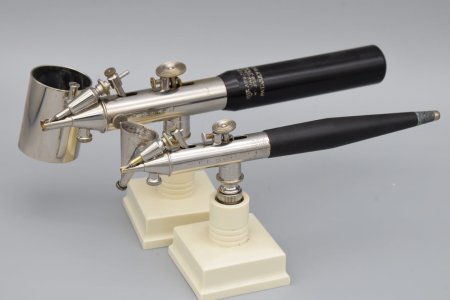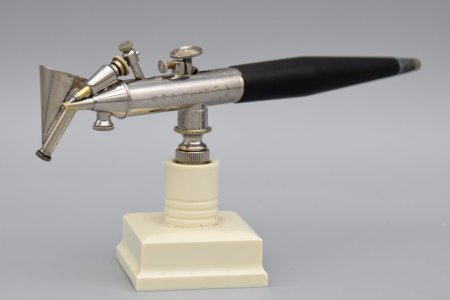DaveG
Airbush Analyst
A while back I made a post about a Wold Model "M" that I had acquired (original post here - https://www.airbrushforum.org/threads/wold-model-m.23040/ ).
At that time I stated that I would love to get my hands on the smaller, less common, Model "N". Well, I found one. Here is a photo of both the larger Model M, and the smaller Model N. It is kind of like having an HP-C, and a smaller HP-B...

When the brush arrived, it came in a cloth covered wooden case that makes me think it is probably from the 1910's to 1920's era (based on other known samples I have). It was evident the brush was used, as there was what I believe was dried ink all over the working bits. So much so, that the feed tube on the color cup was clogged with it. It all cleaned up with some soaking, scrubbing, picking, and soaking some more. Initial spray tests revealed my worst fears that the nozzle which I already knew had a chip out of the front edge, was actually completely toasted. I spent a day searching for a replacement on the net, contacted everyone I could think of contacting, then dug into my own stash to see what I could come up with. I found Wold Model A2 that is in less than stellar condition, and compared the nozzles - finding that they are interchangeable. So, I scavenged the nozzle from the Model A2. Once I had the nozzle installed on the Model N, I found the needle would not protrude far enough to work well - having been fixed, or reshaped several times before. So, I went back to my stash, and found an A2 needle in good condition, which I then cut down, and refinished to fit the Model N.

A little final tweaking, and sealing with wax warmed enough to wick into some of the seams, a spray test revealed that the work was worth it. The brush sprays wonderfully. The spray pattern is soft, and transitions from full coverage at the center, to fades at the end are smooth, and devoid of coarse speckling. The line weight is consistent, and easy to establish, and maintain. Trigger action can only be described a amazingly smooth considering there is a linkage between trigger and needle.

I finally finished it off with a new handle, turned from Ebony. The OEM is wood as well, but I do not want to destroy the aged patina is has earned over the years. I will preserve it as is. The replacement handle has a brass insert for the threaded connection to the body, and a silver bit at the end to replicate the plated tail of the OEM. I finished the handle with a wax, alcohol, shellac mix that could be similar to what may have been period correct for the original. Last bit was to make a QC fitting that I used an OEM hose fitting to model after. The brush is comfortable enough, and functions well enough, that I would not hesitate to grab this thing for daily use - although, the only things I have fed it so far are watercolors, ink, and a little E'tac.

At that time I stated that I would love to get my hands on the smaller, less common, Model "N". Well, I found one. Here is a photo of both the larger Model M, and the smaller Model N. It is kind of like having an HP-C, and a smaller HP-B...

When the brush arrived, it came in a cloth covered wooden case that makes me think it is probably from the 1910's to 1920's era (based on other known samples I have). It was evident the brush was used, as there was what I believe was dried ink all over the working bits. So much so, that the feed tube on the color cup was clogged with it. It all cleaned up with some soaking, scrubbing, picking, and soaking some more. Initial spray tests revealed my worst fears that the nozzle which I already knew had a chip out of the front edge, was actually completely toasted. I spent a day searching for a replacement on the net, contacted everyone I could think of contacting, then dug into my own stash to see what I could come up with. I found Wold Model A2 that is in less than stellar condition, and compared the nozzles - finding that they are interchangeable. So, I scavenged the nozzle from the Model A2. Once I had the nozzle installed on the Model N, I found the needle would not protrude far enough to work well - having been fixed, or reshaped several times before. So, I went back to my stash, and found an A2 needle in good condition, which I then cut down, and refinished to fit the Model N.

A little final tweaking, and sealing with wax warmed enough to wick into some of the seams, a spray test revealed that the work was worth it. The brush sprays wonderfully. The spray pattern is soft, and transitions from full coverage at the center, to fades at the end are smooth, and devoid of coarse speckling. The line weight is consistent, and easy to establish, and maintain. Trigger action can only be described a amazingly smooth considering there is a linkage between trigger and needle.

I finally finished it off with a new handle, turned from Ebony. The OEM is wood as well, but I do not want to destroy the aged patina is has earned over the years. I will preserve it as is. The replacement handle has a brass insert for the threaded connection to the body, and a silver bit at the end to replicate the plated tail of the OEM. I finished the handle with a wax, alcohol, shellac mix that could be similar to what may have been period correct for the original. Last bit was to make a QC fitting that I used an OEM hose fitting to model after. The brush is comfortable enough, and functions well enough, that I would not hesitate to grab this thing for daily use - although, the only things I have fed it so far are watercolors, ink, and a little E'tac.

